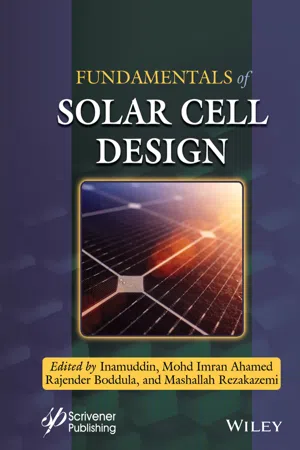
Fundamentals of Solar Cell Design
Mohd Imran Ahamed, Rajender Boddula, Mashallah Rezakazemi
- English
- PDF
- Disponible sur iOS et Android
Fundamentals of Solar Cell Design
Mohd Imran Ahamed, Rajender Boddula, Mashallah Rezakazemi
À propos de ce livre
Edited by one of the most well-respected and prolific engineers in the world and his team, this book provides a comprehensive overview of solar cells and explores the history of evolution and present scenarios of solar cell design, classification, properties, various semiconductor materials, thin films, wafer-scale, transparent solar cells, and other fundamentals of solar cell design.
Solar cells are semiconductor devices that convert light photons into electricity in photovoltaic energy conversion and can help to overcome the global energy crisis. Solar cells have many applications including remote area power systems, earth-orbiting satellites, wristwatches, water pumping, photodetectors and remote radiotelephones. Solar cell technology is economically feasible for commercial-scale power generation. While commercial solar cells exhibit good performance and stability, still researchers are looking at many ways to improve the performance and cost of solar cells via modulating the fundamental properties of semiconductors. Solar cell technology is the key to a clean energy future. Solar cells directly harvested energy from the sun's light radiation into electricity are in an ever-growing demand for future global energy production.
Solar cell-based energy harvesting has attracted worldwide attention for its notable features, such as cheap renewable technology, scalable, lightweight, flexibility, versatility, no greenhouse gas emission, and economy friendly and operational costs. Thus, solar cell technology is at the forefront of renewable energy technologies which are used in telecommunications, power plants, small devices to satellites. Large-scale implementation can be manipulated by various types used in solar cell design and exploration of new materials towards improving performance and reducing cost. Therefore, in-depth knowledge about solar cell design is fundamental for those who wish to apply this knowledge and understanding in industries and academics.
This book provides a comprehensive overview on solar cells and explores the history to evolution and present scenarios of solar cell design, classification, properties, various semiconductor materials, thin films, wafer-scale, transparent solar cells, and so on. It also includes solar cells' characterization, analytical tools, theoretical modeling, practices to enhance conversion efficiencies, applications and patents.
This outstanding new volume:
- Provides state-of-the-art information about solar cells
- Is a unique reference guide for researchers in solar energy
- Includes novel innovations in the field of solar cell technology
Audience: This book is a unique reference guide that can be used by faculty, students, researchers, engineers, device designers and industrialists who are working and learning in the fields of semiconductors, chemistry, physics, electronics, light science, material science, flexible energy conversion, industrial, and renewable energy sectors..